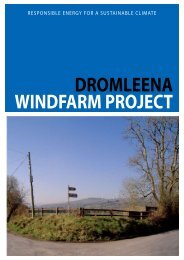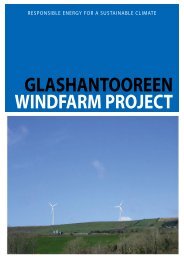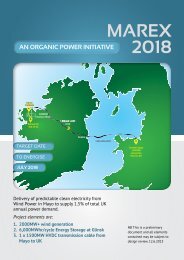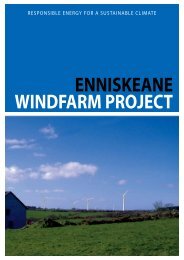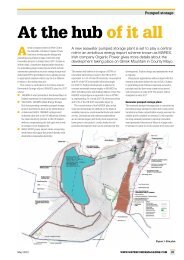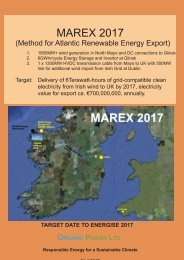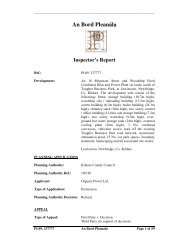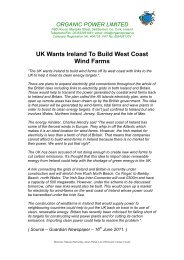MAREX 2016 - Organic Power
MAREX 2016 - Organic Power
MAREX 2016 - Organic Power
Create successful ePaper yourself
Turn your PDF publications into a flip-book with our unique Google optimized e-Paper software.
HVDC TRANSMISSION OVERVIEW<br />
WHY HVDC?<br />
The resource that this initiative wishes to<br />
harness and condition, via wind energy<br />
convertors and energy storage, is geographically<br />
removed from the identified<br />
markets for electricity (the greater Dublin<br />
area and the UK). Woodland is the ideal<br />
location for a connection to both markets.<br />
The problem is how to get the power there.<br />
Overhead power lines are the object of<br />
much public opposition as they are percieved<br />
by many to be visually obtrusive<br />
and some people have concerns regarding<br />
potential risks from electromagnetic<br />
radiation (whether real or imagined).<br />
To allay these concerns, the use of DC<br />
gives 2 distinct advantages, firstly, due<br />
to a much reduced heat loss in DC cables,<br />
they can be buried undersea and<br />
underground without cooling systems<br />
at high voltages, and secondly, electromagnetic<br />
radiation is also much reduced.<br />
Bipolar 700MW Cable used for Norned<br />
THE CABLE<br />
At this preliminary stage, it is very difficult<br />
to describe with any certainty, the actual<br />
specifications of the cable that will be used.<br />
However, given the distances involved<br />
and the obvious benefits of redundancy in<br />
the system, 2 bipolar cables with a high<br />
power rating would appear to be a promising<br />
option. 800MW rated bipolar cables<br />
are commercially available and may be<br />
suitable for the <strong>MAREX</strong> proposal operated<br />
using Voltage source Commutation <strong>Power</strong><br />
control. This would allow each cable to be<br />
operated at 500MW initially with the potential<br />
for increasing the power carried later.<br />
EIRGRID may operate a 600MW connection<br />
cap to the national grid, and<br />
this may constrain the potential power<br />
to be carried by the cable proposed to<br />
connect to the EIRGRID AC system<br />
at Woodland. The rated capacity of<br />
the existing HVDC interconnector to<br />
the UK is 500MW and this limits the<br />
power that can be connected to that.<br />
The advantages of the VSC bipolar<br />
HVDC configuration are:<br />
• Undersea cables, where<br />
high capacitance causes<br />
additional AC losses.<br />
• Endpoint-to-endpoint longhaul<br />
bulk power transmission<br />
without intermediate ‘taps’,<br />
for example, in remote areas.<br />
• Increasing the capacity of an<br />
existing power grid in situations<br />
where additional wires are<br />
difficult or expensive to install<br />
• <strong>Power</strong> transmission and stabilization<br />
between unsynchronised<br />
AC distribution systems<br />
• Connecting a remote generating<br />
plant to the distribution grid,<br />
• Stabilizing a predominantly AC<br />
power-grid, without increasing<br />
prospective short circuit current<br />
• Reducing line cost. HVDC<br />
needs fewer thinner conductors<br />
as there is no need<br />
to support multiple phases.<br />
• Synchronize AC produced by<br />
renewable energy sources<br />
• VSC technology provides a<br />
straight forward AC side connection.<br />
The modular multilevel<br />
converter principle renders AC<br />
harmonic filters superfluous.<br />
• A standard transformer design<br />
can be used without special requirements<br />
to withstand DC<br />
voltage or harmonic currents.<br />
• Converters do not produce<br />
any significant high frequency<br />
noise, so outdoor installation of<br />
AC- and DC reactors (if necessary)<br />
and switchgear is feasible.<br />
CABLE INSERTION<br />
At an initial level of examination it is<br />
expected that the cable route from<br />
Glinsk to Woodland will have the following<br />
insertion methods:<br />
• 2 no. 500MW Outdoor convertor<br />
at Glinsk<br />
• 500m Cross shore horizontal directional<br />
drilling section in tunnelled<br />
cable duct.<br />
• 65km approx. smartjet subsea<br />
insertion 2m below sandy substrate.<br />
• 5km approx sand plough insertion<br />
1.2m deep across intertidal<br />
shore Sligo Bay to pier head.<br />
• 1.5km approx. Under road<br />
trench to rail head.<br />
• Verge trench 1.2m deep alongside<br />
permanent way 190km<br />
• Surface trough insertion accross<br />
bridges and through stations.<br />
• Horizontal directional drillingwhere<br />
exceptionally required<br />
in narrow sections of available<br />
wayleave along permanent<br />
way.<br />
• Under Road trench 1.2m deep<br />
from permanent way to Woodland<br />
substation.<br />
• 2 no. 500MW convertors at<br />
Woodland<br />
CABLE COSTS<br />
At this preliminary stage costs are<br />
hard to estimate, however, ballpark<br />
indication from extrapolation,<br />
allows an estimate in the region<br />
of €300,000,000 to be suggested.<br />
This would be paid for in principle<br />
by connection charges, and use<br />
of system charges would cover<br />
running cost. A combined capacity<br />
connection for <strong>MAREX</strong> would<br />
comprise around 2810MW, indicating<br />
a connection charge of approx.<br />
€100,000-120,000/MW.<br />
<strong>Organic</strong> <strong>Power</strong> Ltd



